 Moderation in almost anything in life is advised; in many cases it should be a requirement. I’m currently in Erkheim, Germany, a lovely town about 60 minutes west of Munich. Almost anyone I share this fact with is intrigued and tells me how lucky I am to be working in Europe. In many respects they are correct, except my travel schedule hasn’t had any moderation as I have visited five countries in the last nine days and have had way too many work meetings. As a result, the quality of my current experience is being degraded due to an overload of what should be more enjoyable pastimes.
Moderation in almost anything in life is advised; in many cases it should be a requirement. I’m currently in Erkheim, Germany, a lovely town about 60 minutes west of Munich. Almost anyone I share this fact with is intrigued and tells me how lucky I am to be working in Europe. In many respects they are correct, except my travel schedule hasn’t had any moderation as I have visited five countries in the last nine days and have had way too many work meetings. As a result, the quality of my current experience is being degraded due to an overload of what should be more enjoyable pastimes.
The key is moderation. A lot of buzz and discussion is constantly going around the ad industry about data, including behavioral data, first-party data, third-party data, contextual data, retargeting age, demographic data, remarketing data, and so forth. There are too many conversations about wanting to utilize more and more data and media planners just blindly applying one data layer on top of each other without actually analyzing the quality, consequence, overall worth, and return on investment (ROI) of the different data layers.
Below outlines three easy ways to know when you are data obese.
1.) Not enough available users. You are excited, the client is excited. You both believe you have written and signed off on the most strategic media plan ever written. Then the campaign goes live and the impression volume just isn’t there. It starts with a fizzle and doesn’t ramp to any worthwhile amount no matter what you do. When this happens there are many different variables that should be re-examined, but if the campaign is extremely data intense, then start by digging into the number of unique users who are actually meeting the requirements you have implemented. Wanting to reach the 18-35-year-old woman on Mondays and Wednesdays only between 11:00 am and 1:00 pm who makes $100,000+ a year, has a college degree, lives within the Zip code of 87123, has two children, and only visits the nine vegetarian-focused websites you are targeting might not work. It might be a great strategy in theory for the high-end vegetarian restaurant that is located in the 87123 Zip code, but if you aren’t reaching any or enough unique users, then you won’t be creating any or enough active customers. As a result, the “best” media plan ever written won’t get any traction because it is too data obese to get off the couch. Take another look at the media plan and the suggested data you are wanting to target and start readjusting, removing, and making a new strategy.
2.) Not ROI positive. This one is simple and requires much less detail and sarcasm to get the point across. Each layer of data you add to a media plan increases the effective cost per thousand (CPM). As a result, you could create a media plan with a very high effective CPM that makes it impossible or very difficult to generate an effective cost per acquisition (CPA) value that is ROI positive. If this is the case, then you have a problem, regardless of how much sexy data you are proposing or using. Chances are you can generate a comparable or equal number of conversions with one or two fewer layers of data. Adding data to a campaign increases the cost of the campaign, often forcing you to purchase actual media on websites at a lower rate, which will decrease the quality of banner placement and as a result hurt your campaign’s overall performance. Remove a layer or two of extra data targeting and associated data cost and apply the data savings to the CPM for the media you are buying, which improves your banner placement on the websites you are targeting…and whamo blamo, there’s a fantastic chance that you will not only maintain or increase the campaign’s performance but you will decrease your overall cost and, as a result, increase the campaign’s overall ROI.
3.) If you can’t define, don’t suggest. Chances are if you can’t accurately define the type of data you are suggesting to your client, then you probably shouldn’t be suggesting that type of data. Common sense, right? If you don’t know what you are selling, then either learn what you are selling or don’t sell it. Imagine walking into a high-end restaurant and on the menu is an item you find intriguing and want to learn more about. If you asked your waiter to explain what was in the dish and they explained it inaccurately, then you probably wouldn’t have a successful eating experience. Yes, the waiter might luck out and a couple customers might actually enjoy the meal, but in the long run the waiter will start getting disappointed and annoyed customers. The customers will lose confidence not only in the waiter but in the entire restaurant as a whole. Chances are these unhappy customers will go somewhere else. In short, if you don’t know what you are talking about, then doesn’t suggest it to your client as something they should buy.
Article was original published by Tim Nichols on May 23rd, 2012 at Clickz.com


